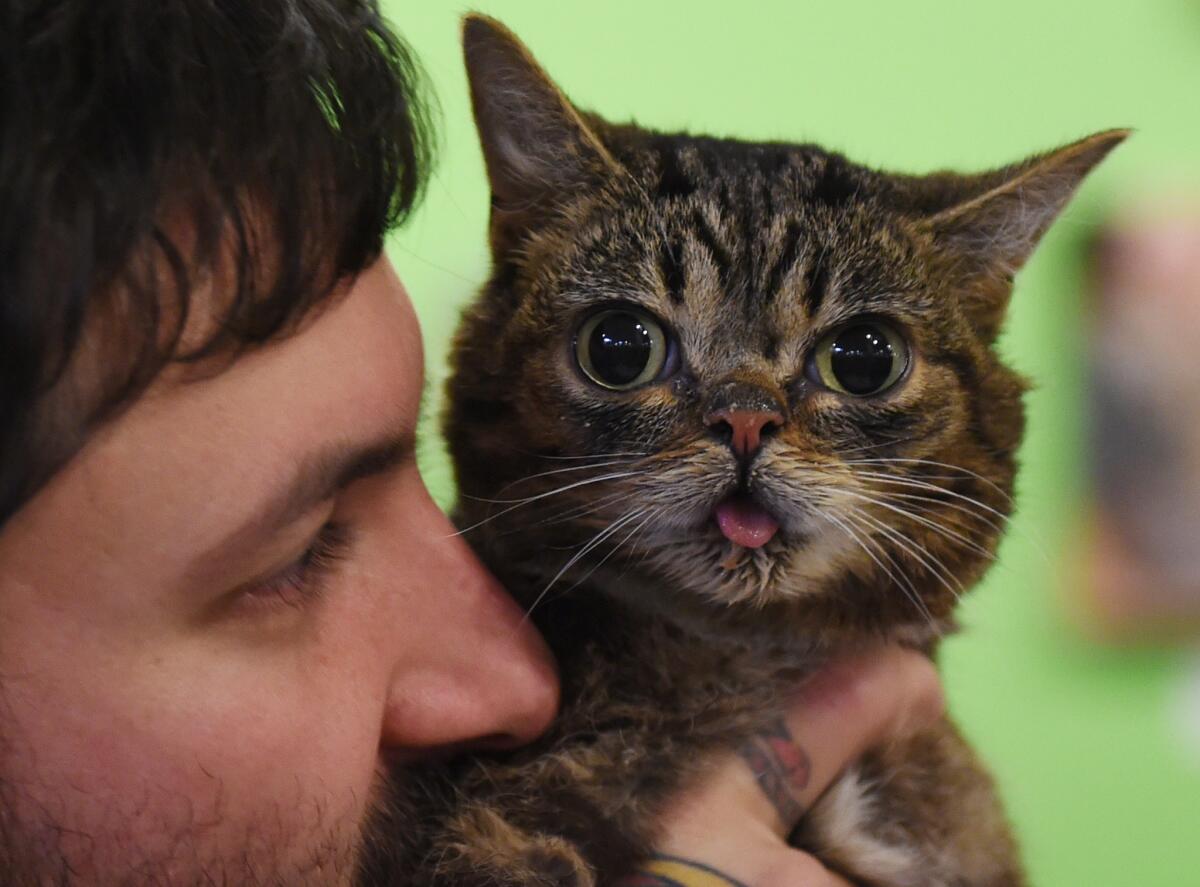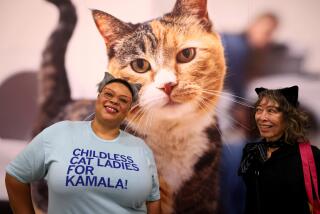How did cats take over the Internet? ‘Cat Video Festival’ founder explains it all

Internet celebrity cat Lil Bub known for her unique appearance is held by owner Mike Bridavsky at the inaugural CatConLa event in Los Angeles.
- Share via
No member of the animal kingdom has conquered the Internet like Felis catus, the humble house cat.
YouTube is home to an estimated 10 million cat videos, which, to put it in perspective, works out to an upload rate of roughly two cat-related pieces of content every minute over the last decade. There’s a blue-shirted keyboard-playing cat (“Charlie Schmidt’s Keyboard Cat! – The Original!” has more than 40 million views since 2007), a kitten raising its paws in surprise (“Surprised Kitty,” https://www.youtube.com/watch%3Fv=0Bmhjf0rKe8 75.6 million views) and a very angry shelter cat from across the pond that’s managed to rack up more than 88 million hits since 2006 (“Very Angry Cat”).
The phenomenon has made household names of Grumpy Cat (real name Tardar Sauce), whose endorsement deals, media appearances, 2014 movie and upcoming comic book have generated a reported six figures, and Lil Bub, a talk-show-hosting special-needs rescue cat that’s helped raise more than $200,000 for the ASPCA since 2012.
Share your photos: Show us your pets, and tell us how you “met”
How did the cats-on-the-Internet meme become so entrenched in pop culture that the phenomenon was recently footnoted in congressional testimony on the use of Internet bandwidth and referenced in the CIA’s official Twitter feed?
To help answer that question, we turned to someone who may have watched more of those 10 million YouTube videos than anyone else on the planet: Scott Stulen, the curator of audience experiences at the Indianapolis Museum of Art and organizer of the first Internet Cat Video Festival at the Walker Art Center in Minneapolis in 2012:
What is it about cats that make them such popular video subjects?
They have their own personalities, they act like they don’t need us and they operate very independently. So there’s a sense that they’re not performing for us. Within that, we start to project very human personas, traits and characteristics onto them.
Check out the all-new L.A. Times Pets page
There’s also the practical thing of them being in the home all the time and everybody has a video camera now, so that helps fuel the relationship.
Why don’t dog videos seem to capture our collective attention in the same way?
While dog owners have a lot of social spaces that exist — going out to the dog park or going out for a walk — cat owners are primarily [interacting from] home and don’t have the same options. So in a lot of ways the Internet — and cat videos — became the cat park, a place where cat owners interact with one another and share things.
What would you consider the Golden Age of Internet cat videos? Are we there now?
To me the Golden Age was probably like the Golden Age of YouTube, when the monetary piece wasn’t such a part of it. I’d say 2008 to 2012 was probably the sweet spot, bookended by the “Keyboard Cat” video that was posted in 2007, and the Henri [LeChatNoir] videos from 2012 and a little after. That’s the window: pre-Grumpy Cat, pre-Lil Bub, where things shifted a bit. I’m not saying it’s good or it’s bad; it’s just changed.”
Can you think of anything that could ever dislodge the cat video meme’s place in our collective conscience?
I would have thought it would have already happened by now because the life span of a typical meme is so short and this has lived on now for a solid four or five years at full speed and doesn’t show any signs of weakening yet. But I think the platforms it lives on will change — I’m sure there are already Periscope channels that are streaming cats everywhere.
MORE:
Thomas Edison, inventor of ... the cat video?
Do you follow? These pets are viral sensations on social media
Instagram star in the making? 6 tips for photographing your pet
More to Read
Sign up for The Wild
We’ll help you find the best places to hike, bike and run, as well as the perfect silent spots for meditation and yoga.
You may occasionally receive promotional content from the Los Angeles Times.











